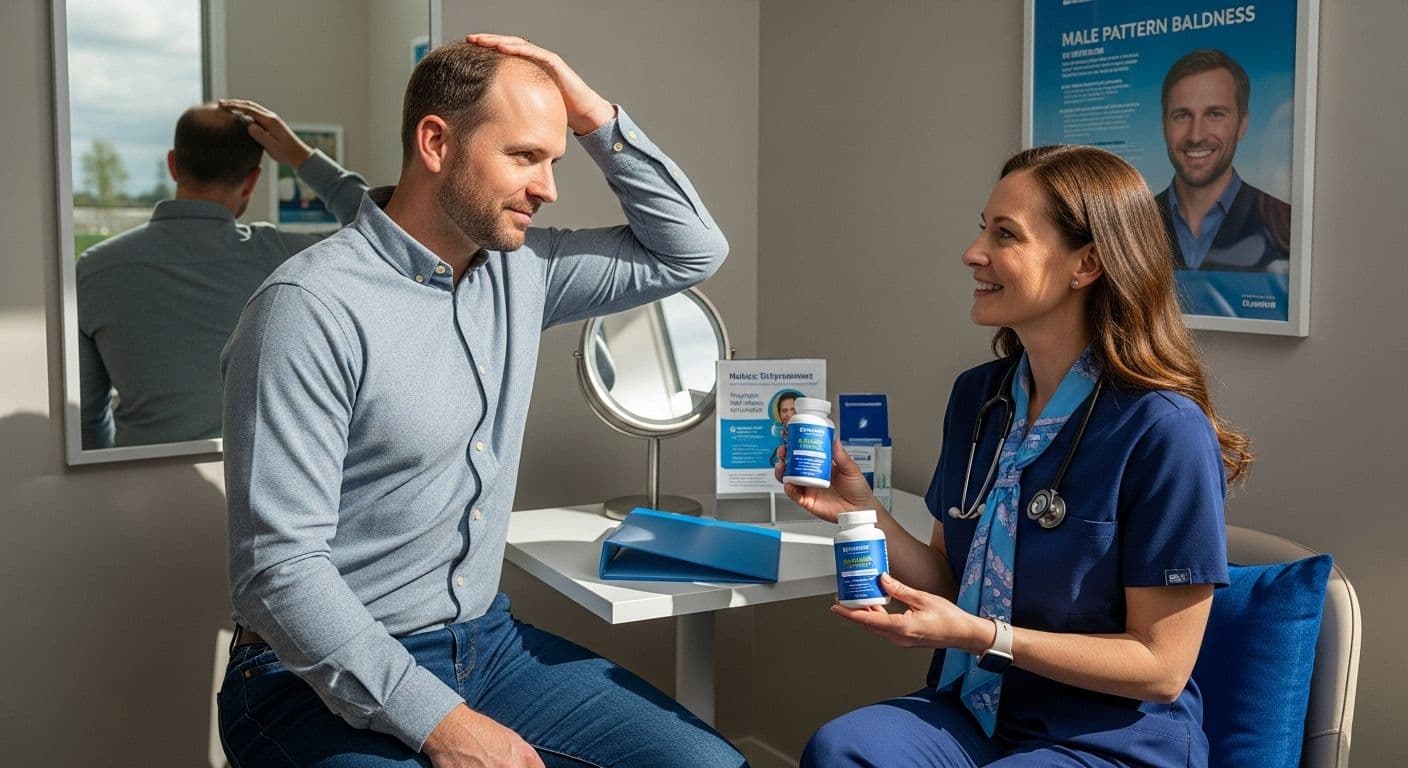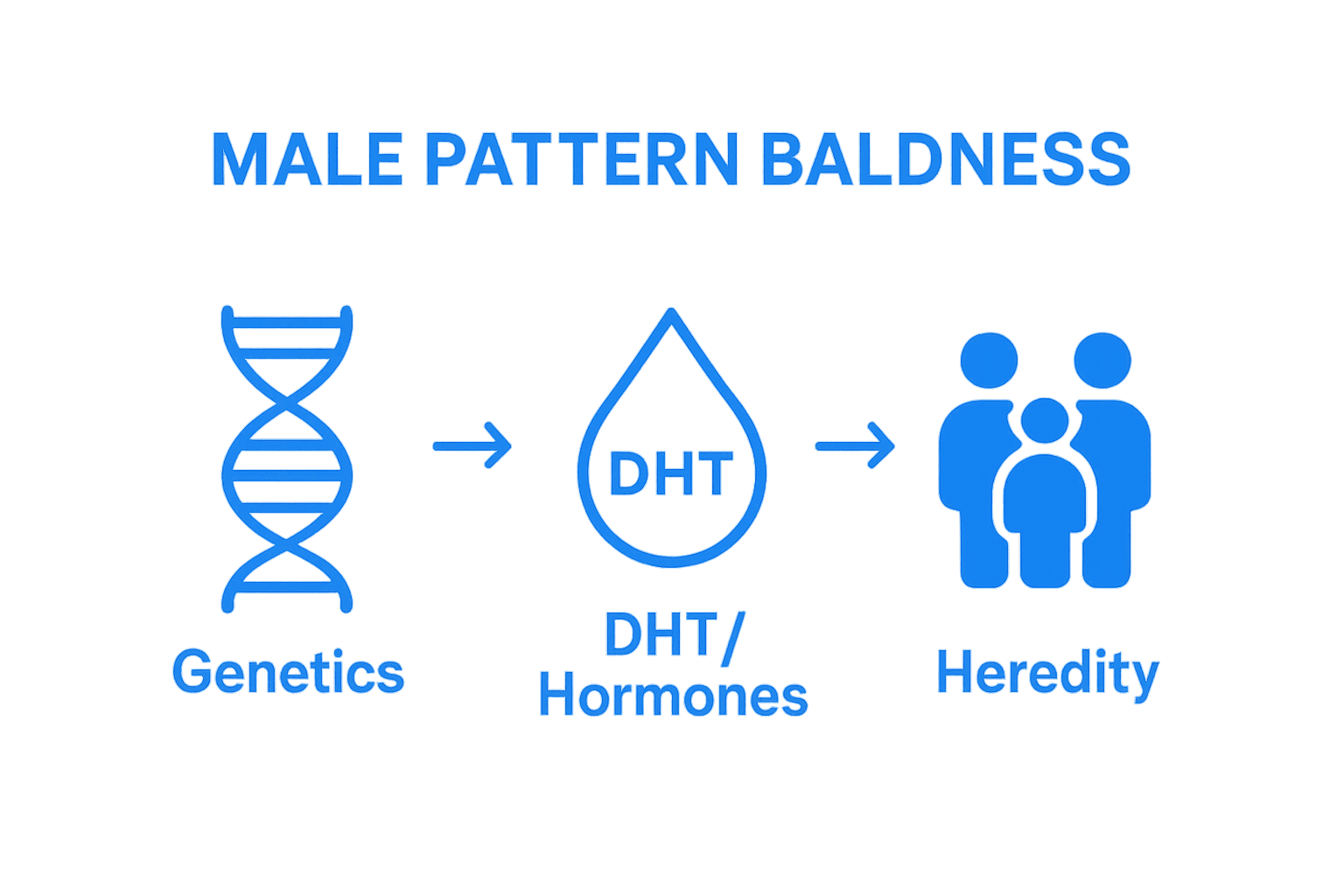Blog
Learning Materials
Understanding Male Pattern Baldness Natural Treatment
Updated: September 4, 2025

Male pattern baldness is not just a cosmetic nuisance. It is a genetic shift that impacts over 50 million men in the United States alone. Most expect science fiction levels of complexity behind why hair disappears, but the real story is both striking and simple. The biggest culprits are actually just your inherited genes and one hormone working a silent transformation right on your scalp.
Table of Contents
- What Is Male Pattern Baldness And Its Causes?
- Why Male Pattern Baldness Matters To Individuals And Society
- How Natural Treatments For Male Pattern Baldness Work
- Key Concepts Behind Natural Remedies For Hair Restoration
Quick Summary
| Takeaway | Explanation |
|---|---|
| Genetics and hormone levels drive baldness | Male pattern baldness is caused by genetic factors and DHT hormone sensitivity affecting hair follicles. |
| Understand common hair loss patterns | Hair loss typically starts at the temples and crown, leading to receding hairlines and bald spots. |
| DHT-blocking natural treatments exist | Natural remedies like saw palmetto may help inhibit DHT levels, promoting healthier hair growth. |
| Emotional effects of baldness are real | Hair loss can significantly impact self-esteem and societal perceptions of masculinity and attractiveness. |
| Holistic strategies can support hair health | Combining natural treatments with lifestyle changes offers a comprehensive approach for managing hair loss. |
What is Male Pattern Baldness and Its Causes?
Male pattern baldness, scientifically termed androgenetic alopecia, represents a complex genetic condition affecting millions of men worldwide. Unlike random hair loss, this specific pattern of hair reduction follows a predictable progression that transforms hair growth dynamics at the follicular level.
Understanding the Genetic Blueprint
The root cause of male pattern baldness stems from a potent interaction between genetic predisposition and hormonal influences. Researchers from the National Institutes of Health have demonstrated that specific genes inherited from both maternal and paternal lineages significantly contribute to hair loss susceptibility. These genetic markers influence how hair follicles respond to androgens, particularly dihydrotestosterone (DHT), a testosterone derivative that plays a critical role in hair follicle miniaturization.

Key genetic factors include:
- Sensitivity of hair follicle receptors to hormonal changes
- Inherited androgen receptor gene variations
- Familial predisposition toward early hair thinning
The Hormonal Mechanism of Hair Loss
DHT triggers a progressive process of hair follicle shrinkage, causing hair strands to become progressively thinner and shorter. This hormonal mechanism explains why male pattern baldness typically starts at the temples and crown, creating the characteristic receding hairline and circular baldness pattern. Learn more about rapid hair loss progression.
The transformation occurs in predictable stages:
- Initial hair thinning and reduced strand diameter
- Gradual reduction in hair growth cycle duration
- Complete follicular miniaturization and potential permanent hair loss
Understanding these intricate biological processes provides crucial insights into why male pattern baldness occurs and how natural treatments might potentially interrupt or slow its progression. Recognizing the underlying genetic and hormonal mechanisms empowers individuals to make informed decisions about potential interventions and hair care strategies.
Why Male Pattern Baldness Matters to Individuals and Society
Male pattern baldness transcends a mere cosmetic concern, representing a profound psychological and social experience that impacts millions of men globally. The implications of hair loss extend far beyond physical appearance, touching deeply personal dimensions of self perception, social interactions, and emotional well being.
Psychological Impact and Self Perception
Researchers investigating the psychological dimensions have uncovered significant emotional consequences associated with male pattern baldness. Men experiencing hair loss frequently report complex psychological responses, including diminished self esteem and increased anxiety about personal attractiveness. The emotional journey involves confronting societal beauty standards and personal identity transformation.
Key psychological challenges include:
- Heightened self consciousness about physical appearance
- Increased vulnerability to social judgment
- Potential development of compensatory behavioral mechanisms
Social and Professional Implications
The societal perception of hair loss can dramatically influence personal and professional interactions. Explore our comprehensive guide on male pattern baldness treatments to understand potential strategies. Studies reveal that hair loss can impact professional confidence, with some individuals reporting reduced perceived competence and leadership potential. The visible manifestation of aging through hair loss triggers complex emotional responses related to masculinity, youth, and social status.
Significant social dynamics include:
- Potential discrimination in professional settings
- Altered social interaction patterns
- Increased investment in alternative appearance enhancement strategies
Recognizing male pattern baldness as more than a physical condition illuminates the intricate relationship between personal identity, societal expectations, and individual emotional resilience.
Below is a table comparing the main genetic, hormonal, psychological, and social factors that contribute to male pattern baldness, summarizing their impact based on the article's explanations.
| Factor | Description | Primary Impact on Baldness |
|---|---|---|
| Genetics | Inherited genes from both parents determine hair follicle sensitivity to DHT. | Sets baseline susceptibility |
| Androgen/Hormonal Influence | DHT hormone, converted from testosterone, shrinks hair follicles. | Triggers and accelerates hair loss |
| Psychological Impact | Emotional responses like lowered self-esteem, increased anxiety. | Affects self-perception and confidence |
| Social and Professional Factors | Societal attitudes, perceived professionalism, altered interactions. | Influences social and work experiences |
| Understanding these multifaceted implications encourages a more compassionate and holistic approach to addressing hair loss experiences. |
How Natural Treatments for Male Pattern Baldness Work
Natural treatments for male pattern baldness represent a holistic approach to addressing hair loss by targeting the underlying biological mechanisms that contribute to follicular degradation. These strategies aim to interrupt the hormonal processes and support hair growth through carefully selected botanical and nutritional interventions.
Biological Mechanisms of Natural Interventions
Researchers examining natural hair loss treatments have identified several key mechanisms by which botanical compounds interact with hair follicle biology. The primary approach involves blocking dihydrotestosterone (DHT) production and reducing its impact on hair follicle miniaturization. Natural compounds work by inhibiting 5-alpha-reductase, the enzyme responsible for converting testosterone into DHT, thereby potentially slowing down the hair loss process.
Key biological intervention strategies include:
- Reducing DHT production at the enzymatic level
- Improving scalp blood circulation
- Providing essential nutrients for hair follicle health
Botanical and Nutritional Approaches
Discover comprehensive strategies for managing hair loss that complement natural treatment methods. Several botanical extracts have demonstrated promising potential in addressing male pattern baldness. Compounds like saw palmetto, pumpkin seed oil, and green tea extract offer multi-dimensional approaches to supporting hair growth and preventing further loss.
Significant natural treatment components include:
- Saw palmetto extract for DHT reduction
- Pumpkin seed oil to support hormonal balance
- Green tea extract for potential anti-inflammatory effects
While natural treatments show potential, they represent a complementary approach rather than a definitive cure. The complexity of male pattern baldness requires a nuanced understanding of individual genetic, hormonal, and environmental factors. Effective management involves a comprehensive strategy that combines natural interventions, lifestyle modifications, and potentially professional medical guidance.
This table summarizes the characteristics and actions of key natural ingredients highlighted in the article as potential interventions for male pattern baldness.
| Ingredient | Main Action | Potential Benefit for Hair Health |
|---|---|---|
| Saw Palmetto | Blocks DHT production | May slow hair loss and promote growth |
| Pumpkin Seed Oil | Supports hormonal balance | Helps maintain scalp and follicle health |
| Green Tea Extract | Anti-inflammatory and antioxidant | May support scalp health and reduce follicle damage |
| Rosemary Oil | Enhances microcirculation | Improves nutrient delivery to follicles |

Key Concepts Behind Natural Remedies for Hair Restoration
Natural hair restoration approaches represent a sophisticated intersection of botanical science, biochemical understanding, and holistic health strategies. These methods go beyond superficial treatment, targeting the fundamental biological processes that influence hair growth and follicular health.
Biochemical Foundations of Natural Interventions
Researchers investigating herbal hair restoration techniques have uncovered intricate mechanisms by which natural compounds interact with hair follicle biology. The primary objective involves modulating hormonal pathways, reducing inflammation, and providing essential nutritional support to create an optimal environment for hair regeneration.
Critical biochemical intervention principles include:
- Blocking testosterone conversion to dihydrotestosterone
- Improving microcirculation in scalp tissues
- Neutralizing oxidative stress at follicular levels
Nutritional and Botanical Synergy
Explore comprehensive insights into herbal hair growth solutions that reveal the complex interactions between botanical compounds. Natural remedies leverage a multifaceted approach, combining ingredients that work synergistically to address different aspects of hair loss. Key botanical agents like saw palmetto, green tea extract, and rosemary oil demonstrate remarkable potential in supporting hair follicle resilience and promoting healthy growth patterns.
Significant natural restoration components include:
- Adaptogenic herbs that balance hormonal systems
- Antioxidant-rich extracts supporting cellular health
- Mineral and vitamin complexes enhancing follicular nutrition
Understanding natural hair restoration requires recognizing the intricate balance between genetic predisposition, environmental factors, and holistic health strategies. These approaches do not promise miraculous overnight transformations but offer a nuanced, supportive framework for managing male pattern baldness through comprehensive biological intervention.
Take Control of Your Hair Loss Journey with MyHair.ai
Struggling with male pattern baldness can be overwhelming, especially when genetic and hormonal factors seem out of your hands. You learned in this article how complex the causes of hair loss are, and how natural treatments like blocking DHT or optimizing scalp health aim to slow down hair thinning. But seeing real change means starting with the right personalized insights—knowing exactly how your hair is changing and what solutions fit your unique needs.

Let MyHair.ai guide you with science-backed, AI-powered hair health analysis. Upload your scan for a detailed assessment, receive tailored product recommendations that match your hair’s genetic and environmental profile, and track your results over time. If you are curious about the difference a personalized approach can make, get started right now and experience the confidence of actionable data and expert support. Your hair restoration journey should be built on what makes you unique—discover your next steps today.
Frequently Asked Questions
What is male pattern baldness?
Male pattern baldness, also known as androgenetic alopecia, is a genetic condition characterized by predictable hair loss patterns in men, often beginning at the temples and crown.
What causes male pattern baldness?
The primary causes include genetic predisposition and hormonal influences, particularly the interaction of hair follicles with dihydrotestosterone (DHT), a derivative of testosterone.
How do natural treatments work for male pattern baldness?
Natural treatments aim to address the underlying biological mechanisms of hair loss by blocking DHT production, improving blood circulation to the scalp, and providing essential nutrients for hair follicle health.
What are some effective natural ingredients for treating male pattern baldness?
Effective natural ingredients include saw palmetto, pumpkin seed oil, and green tea extract, which may help reduce DHT levels and support overall scalp health.